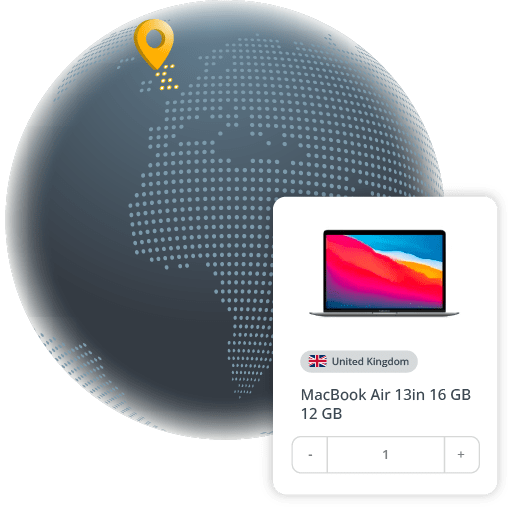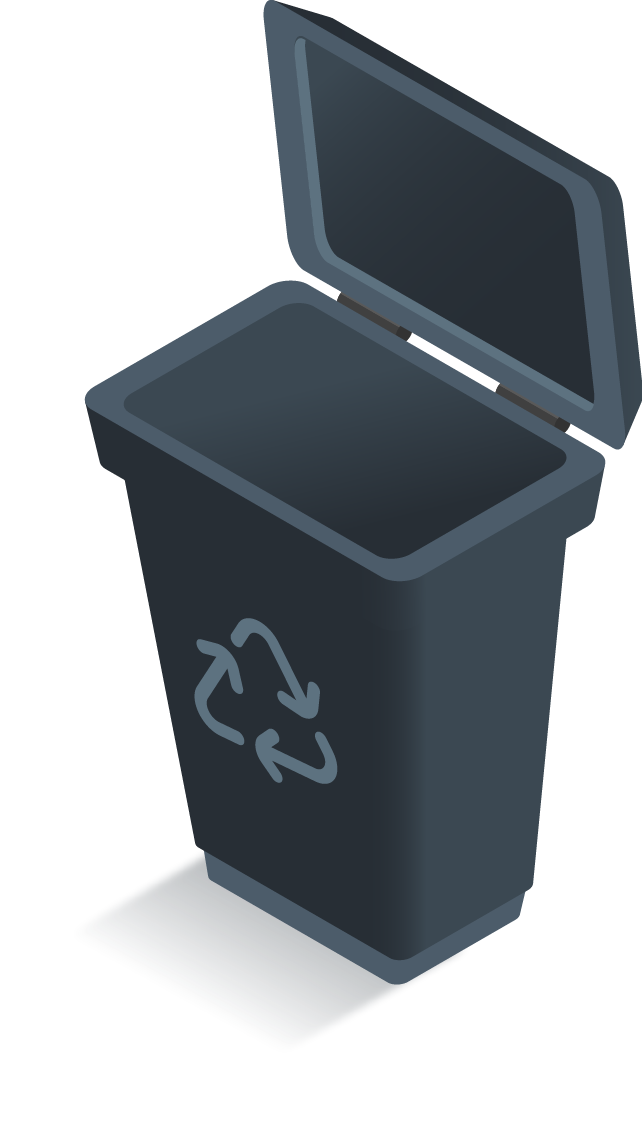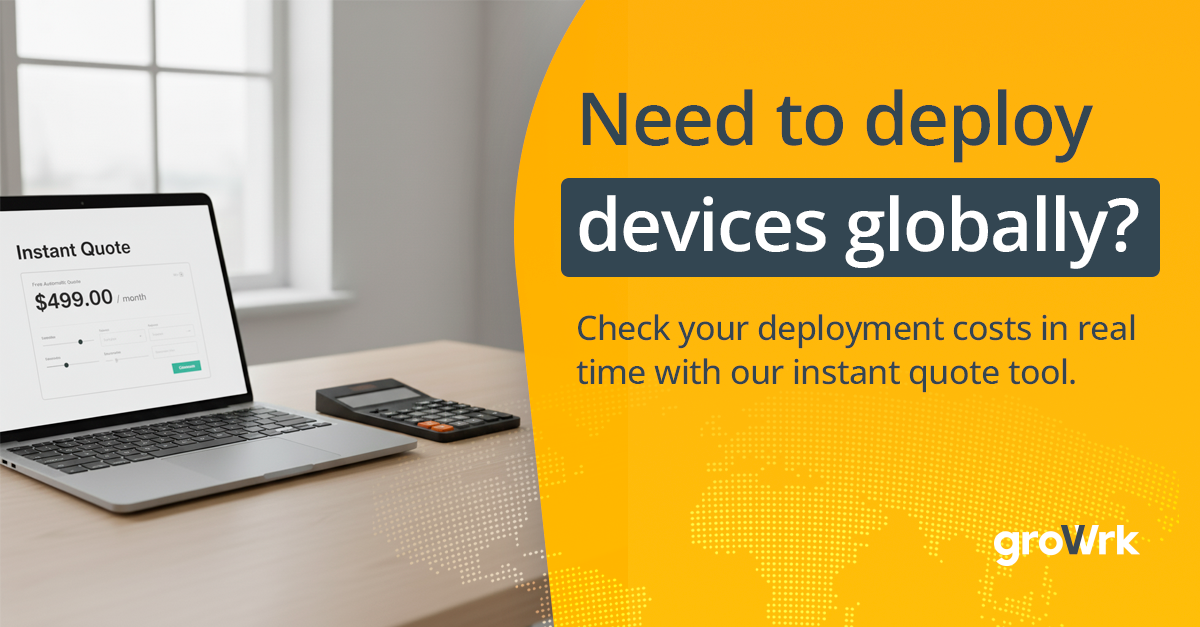How to send IT equipment to the UK
Are you looking to ship laptops or other IT equipment to remote teams in the UK? GroWrk is here to streamline your IT asset management, logistics, and compliance across borders. Let’s discover how to effortlessly handle shipping, customs, and IT outsourcing for your distributed workforce.

At a glance
Before shipping IT equipment or outsourcing IT services to the UK, several important factors must be considered. The UK is a leading hub for technology and innovation, with a well-established IT ecosystem. Understanding the local market, regulations, and service providers is crucial for businesses planning to send equipment or outsource IT services to the UK.
|
CURRENCY British Pound (GBP) |
OFFICIAL LANGUAGE English |
TIME ZONE GMT+00:00 (GMT+01:00 during daylight saving time) |
|
CUSTOMS DUTY ON ELECTRONICS 0-5% + 20% VAT Generally 0-5% customs duties and 20% VAT, with potential reductions on certain goods |
SHIPPING LEAD TIME 3-7 days (depending on location and shipping method) |
IT OUTSOURCING MARKET $15.8 billion $15.8 billion in 2024, predicted to see a significant increase in revenue, with projections indicating that it will reach $44.40 billion by 2025. |
Overview of IT operations in the UK

Digital Transformation: The UK has rapidly adopted emerging technologies like Artificial Intelligence (AI), machine learning, blockchain, and 5G. Industries from finance to healthcare are increasingly leveraging digital solutions for greater efficiency and innovation.
Government Initiatives: The UK government is actively investing in digital infrastructure and innovation through initiatives like the "National AI Strategy" and "Digital Strategy 2025." These programs aim to position the UK as a global leader in technology and attract further foreign investment.
Skilled Workforce: The UK has a large, highly skilled IT workforce, particularly in fields like cybersecurity, software development, and data science. The country benefits from world-class universities and research institutions, producing top-tier tech talent.
IT Market Growth: The UK’s IT market continues to grow steadily, with the technology sector expected to reach US$114 billion by 2025. The rise of cloud computing, cybersecurity, and digital services has been a key driver.
Data Privacy and Compliance: The UK is home to some of the strictest data protection regulations in the world, including compliance with the General Data Protection Regulation (GDPR). This makes it an attractive location for businesses seeking to meet high standards of data privacy.
Geographical Advantage: The UK’s strategic location within Europe and close ties to the US make it a key global hub for IT services, particularly in fintech and cybersecurity. London remains one of the leading cities for tech innovation and digital services.
Shipping IT equipment to the UK: What you need to know
| Customs regulations |
UK Customs Authority: The UK customs authority responsible for regulating imports is HM Revenue & Customs (HMRC). All shipments, including IT equipment, must comply with UK customs laws, which include clearance procedures, classification of goods, and adherence to VAT and duty requirements. Post-Brexit Changes: Since the UK left the European Union (EU), goods imported from EU countries are subject to customs checks, including customs declarations and VAT. Shipments from non-EU countries, however, follow the same customs rules as before. Customs Declarations: Shipments from both the EU and non-EU countries now require a customs declaration, either completed by the shipper, freight forwarder, or customs broker. Customs Clearance: Shipments must pass through customs clearance, which involves submitting documents, paying duties, and possibly undergoing inspections. |
| Duties and taxes |
The UK imposes customs duties on most goods, including IT equipment, which are calculated based on the customs value of the goods. The duty rates vary depending on the product category. Generally, for IT equipment such as computers, laptops, and peripherals, the duty rate is 0-5%.
Value Added Tax (VAT):
Customs Duty + VAT: The total cost to the importer will include both the duty and VAT charges, and these must be paid before the goods are cleared. |
| Required documentation |
|
| Import restrictions |
Export Control Regulations: WEEE Regulations (E-Waste): Battery Regulations:
|
| New vs. Used equipment |
| New IT equipment is straightforward in terms of VAT and duties. Used or refurbished equipment must comply with WEEE regulations and may require proof of proper disposal/recycling. |
| Penalties or fines for non-compliance |
|
Checklist for sending laptops to the UK
When shipping laptops to the UK, it’s important to follow a few best practices to ensure the process goes smoothly, and your equipment arrives safely and on time. Here are some helpful shipping tips:

Select trusted couriers: Choose reliable couriers such as GroWrk, DHL, UPS, FedEx, or Royal Mail (ParcelForce, DPD UK, Evri) for international shipping. These carriers offer tracking services and have experience handling UK customs procedures.
Check service levels: Select the appropriate shipping option based on urgency. Express shipping (2-5 days) for high-priority deliveries. Standard shipping (5-10 days) for cost-effective options.
Use high-quality packaging: Secure laptops with sturdy, padded boxes and protective materials like bubble wrap, foam inserts, or air cushions to prevent damage during transit.
Disassemble where possible: If shipping accessories like chargers, docking stations, or monitors, package them separately to prevent damage. Remove detachable components if applicable.
Label clearly: Ensure the recipient’s name, address, and contact details are correctly labeled. Mark the package as "fragile" to encourage careful handling.
Accurate product descriptions: On the commercial invoice, provide a detailed and accurate description of the laptop, including its brand, model, and serial number. Inaccurate descriptions may cause customs delays.
Value declaration: Declare the correct value of the laptop to avoid under- or over-declaring, which could lead to customs inspections or fines. The declared value determines any applicable duties and taxes.
Customs declarations: Since the UK is no longer in the EU, all international shipments require customs clearance. They should include: UK Customs Declaration, Commercial Invoice, and Packing List.
Proof of origin: If applicable, include a certificate of origin to determine eligibility for preferential trade agreements, such as the UK-EU Trade and Cooperation Agreement (TCA), which may reduce duties.
Understand import duties & taxes: Laptops are duty-free under the UK tariff system but are subject to 20% VAT on the declared value, including shipping costs. Customs processing fees may apply depending on the courier.
Pre-pay duties and taxes: Some couriers allow for pre-paid duties and taxes to simplify customs clearance and prevent the recipient from facing unexpected charges upon arrival.
Protect against loss or damage: Consider purchasing shipping insurance for high-value laptops to protect against loss, theft, or damage during transit.
Compliance with UK regulations: Ensure compliance with UKCA (UK Conformity Assessed) marking, which has replaced CE marking for electronic goods in Great Britain, and WEEE (Waste Electrical and Electronic Equipment) and RoHS (Restriction of Hazardous Substances) regulations before shipping.
Use tracking tools: Major couriers provide real-time tracking—monitor shipments closely to anticipate customs clearance updates and delivery progress.
Stay in touch with the recipient: Notify the recipient about the expected delivery timeline, tracking updates, and any customs-related requirements to avoid delays.
Expect weather and seasonal delays: Winter conditions and peak shipping periods (e.g., Christmas, Black Friday, UK public holidays) may cause delivery delays. Plan shipments accordingly.
UK domestic delivery options: For final delivery, consider working with Royal Mail, DPD UK, Evri (formerly Hermes), or Yodel for efficient last-mile distribution.

Average cost of IT Equipment in the UK
Laptops (Business Grade):
- Mid-range: £600 - £1,200
- High-end: £1,200 - £2,500
High-end models such as Apple MacBook Pro, Dell XPS, and Lenovo ThinkPad are priced on the higher end.
Monitors (Business Grade):
- Standard: £100 - £300
- Ultrawide/4K: £400 - £800
Monitors from trusted brands like Dell, Samsung, and LG typically range within these prices, with 4K or ultrawide models costing more.
Desktops (Business Grade):
- Standard Desktop PC: £400 - £1,200
- Workstation Desktop (for high-performance tasks): £1,200 - £3,000+
Prices depend on the brand and specifications, with options from HP, Lenovo, and Apple among the most common.
Printers (Laser):
- Standard Office Printers: £100 - £300
- High-Volume Printers: £500 - £1,500
Leading brands such as HP, Canon, and Brother offer a wide range of models for office environments.
Public holidays & IT work hours to plan your shipment
Key public holidays in the UK:
- New Year’s Day – January 1
- Good Friday – Variable (usually in April)
- Easter Monday – Variable (usually in April)
- May Day Bank Holiday – First Monday in May
- Spring Bank Holiday – Last Monday in May
- Summer Bank Holiday – Last Monday in August (England, Wales, and Northern Ireland only)
- Christmas Day – December 25
- Boxing Day – December 26
Typical work hours for IT professionals
- Standard work hours in the UK are typically from 9:00 AM to 5:00 PM, Monday to Friday with a 1-hour lunch break. However, some businesses—especially those in tech and IT—may operate outside these hours due to the nature of their services, including providing customer support and managing time-sensitive projects.
What to consider when retrieving IT equipment from employees in the UK
| Local delivery and logistics services |
|
| Inventory management |
|
| Logistics challenges for remote locations |
Shipping IT equipment to remote locations in the UK can present logistical challenges, such as longer delivery times and higher costs. These locations may have limited courier service availability, which can lead to delays or reliance on less frequent delivery schedules. Additionally, rural areas may lack the infrastructure for quick, reliable deliveries, requiring advanced planning to ensure the equipment arrives on time and in good condition. Another issue is the increased cost of transportation to remote regions. Couriers often charge more for deliveries to these areas due to the additional distance, fuel costs, and potential need for specialized vehicles. Businesses may also encounter difficulties with coordinating returns, as remote employees may have fewer local drop-off points, requiring extra arrangements for collection or shipping. |
| Equipment agreement with employees |
The equipment agreement should cover key aspects like the ownership of the equipment, acceptable usage policies, maintenance and repair responsibilities, and procedures for returning or replacing damaged items. It should also address issues like data security, including the need for employees to protect company information on devices. A formal agreement ensures compliance with company policies and legal regulations, reduces the risk of asset loss or damage, and provides a clear process for recovering company property. |
How to dispose of IT equipment in the UK
Data wiping and security
- Erase all data from devices to ensure compliance with the Data Protection Act 2018 and GDPR.
- Use certified data-wiping software (e.g., Blancco or DBAN) or engage a professional data destruction service.
- Consider physical destruction (e.g., shredding or crushing hard drives) for highly sensitive equipment.
Check for functionality
- Assess if the equipment can be reused or refurbished. If the equipment is still functional, consider donating or reselling it.
- Donate to charities or schools: Many organizations accept used but functional equipment, promoting reuse.
- Resell or trade-in: Consider reselling through platforms like Recycling Hub or working with certified IT asset recovery companies.
Recycle through WEEE-compliant centres
- Ensure the equipment is disposed of at a WEEE-compliant recycling facility. These centres are legally responsible for handling electrical and electronic waste in an environmentally-friendly manner.
- Contact your local council or a licensed e-waste disposal service to find registered WEEE recyclers. Many services offer free collection for business waste.
Consider certified disposal services
- Engage a WEEE-certified disposal service for both collection and recycling. These companies ensure compliance with UK environmental laws and provide certificates of disposal for your records.
- Make sure the disposal service provides a waste transfer note as proof of disposal, which is required for environmental audits.
Ensure legal compliance
- Keep records of the disposal process, including the date of disposal, data destruction certification, and the recycling company’s details.
- This documentation is important for compliance with environmental regulations and for corporate social responsibility (CSR) reporting.
Consider the environment
- Opt for recycling options that minimize environmental impact, ensuring that hazardous materials like batteries and toxic chemicals are properly managed.
- Look for recycling centres that follow ISO 14001 standards for environmental management.

Local IT Outsourcing Solutions in the UK
You can streamline your IT logistics and asset management with GroWrk’s comprehensive global solution. Whether it’s shipping equipment or managing IT assets across multiple regions, GroWrk helps you stay compliant and efficient, every step of the way. Here’s why GroWrk is the ideal partner for managing your IT assets in the UK:

| 1. Wide global coverage |
| With operations in over 150 countries, including the UK, GroWrk ensures efficient IT deployment and management for remote teams. Whether your employees are in London, Manchester, Edinburgh, or remote locations, we handle everything—so your team stays productive without logistical challenges. |
| 2. End-to-end asset management |
From procurement and deployment to retrieval and disposal, GroWrk simplifies every stage of IT asset management. We take care of logistics, compliance, and security, allowing your team to focus on business growth while we manage IT infrastructure. |
| 3. Intuitive platform for easy deployment |
Our intuitive platform makes it easy to order, ship, and track IT equipment across the UK. Employees receive pre-configured, ready-to-use devices, reducing administrative overhead and ensuring smooth onboarding. |
| 4. Smooth delivery and equipment retrieval |
GroWrk ensures on-time delivery and hassle-free retrieval of IT assets across the UK. Whether deploying laptops, monitors, or accessories or retrieving devices from departing employees, we streamline the process for maximum efficiency. |
| 5. Compliance with British import regulations |
The UK has strict customs, VAT, and compliance requirements for IT shipments. GroWrk ensures CE marking, WEEE disposal, and tax compliance, preventing delays, penalties, or unexpected costs. |
| 6. Efficient repairs and maintenance |
We manage hardware repairs, replacements, and maintenance to keep your IT assets in top condition. Whether through on-site servicing or remote troubleshooting, GroWrk minimizes downtime and ensures business continuity. |
| 7. 24/7 Support for peace of mind |
From shipping assistance and compliance management to real-time troubleshooting, GroWrk’s 24/7 support ensures smooth IT operations, keeping your remote workforce in the UK fully equipped. |
Procure, configure, and deploy your IT devices from one platform


